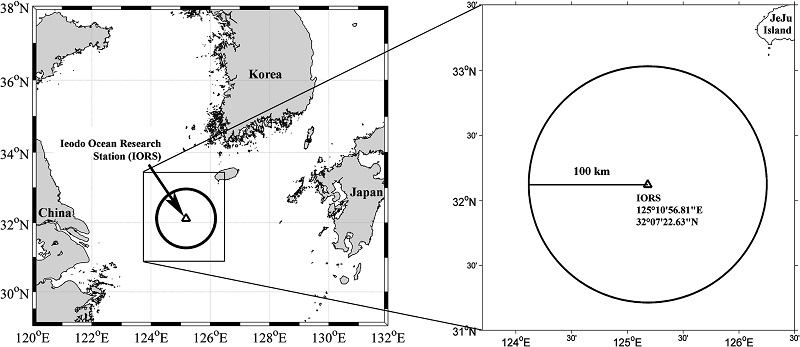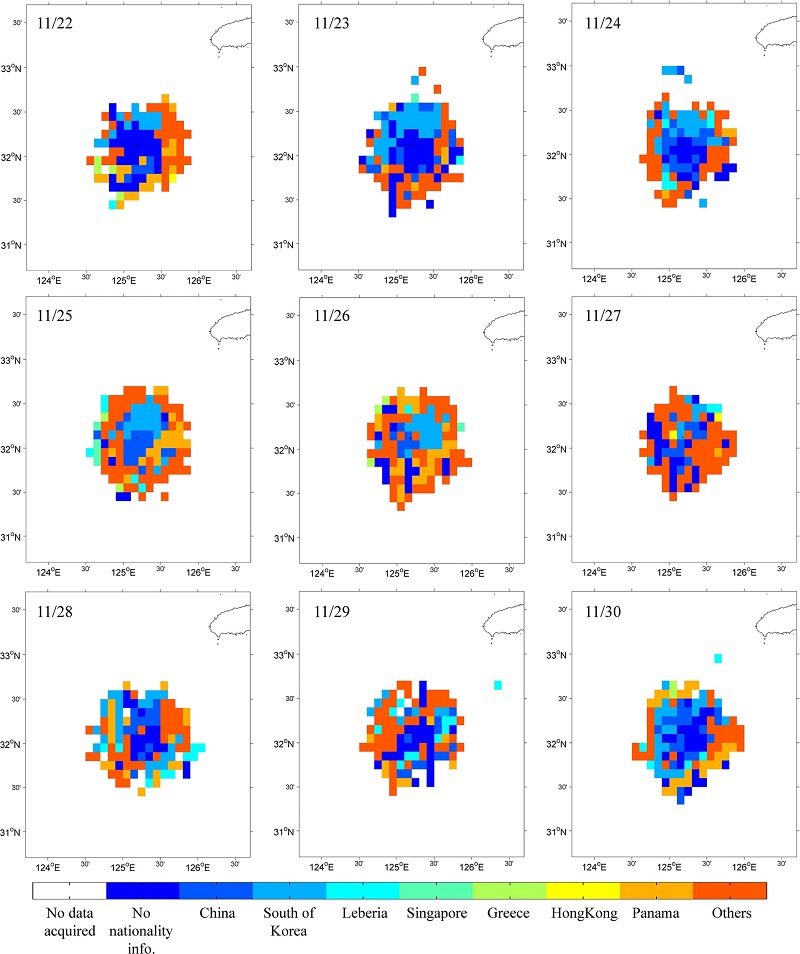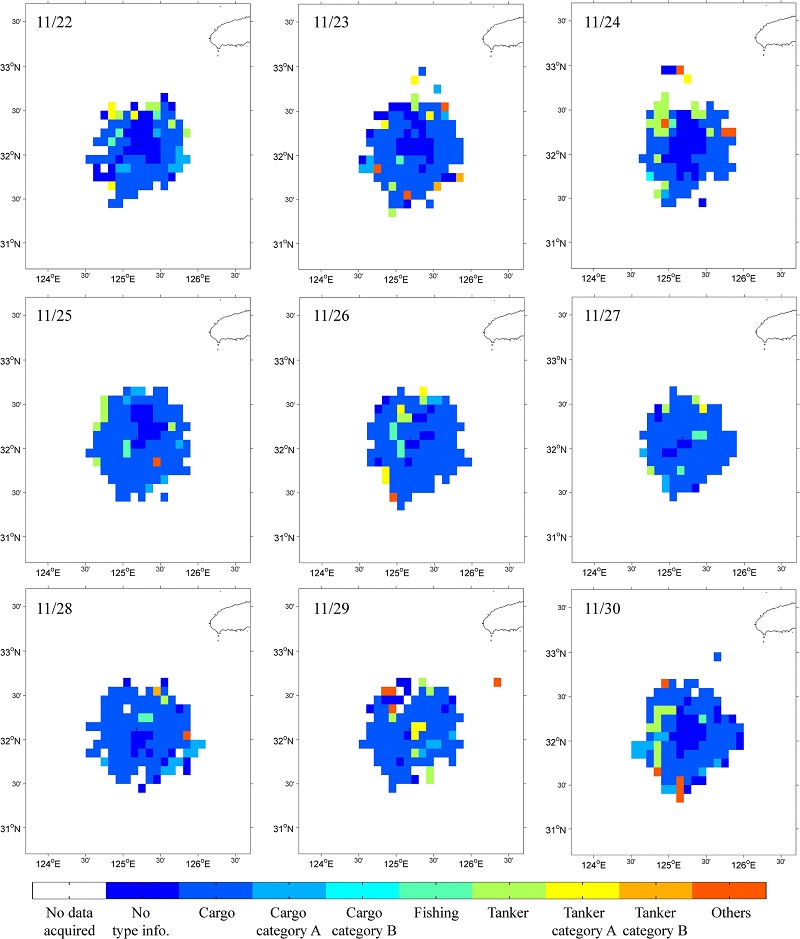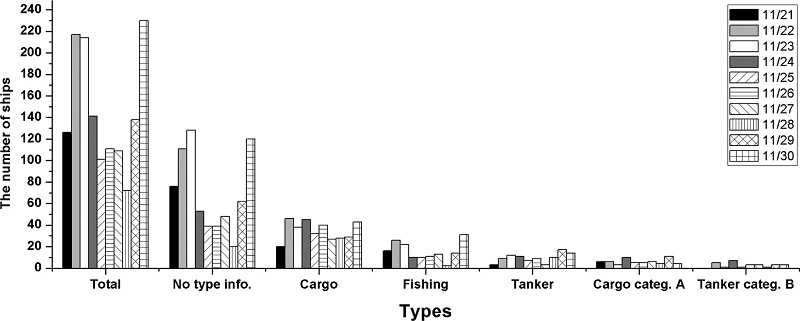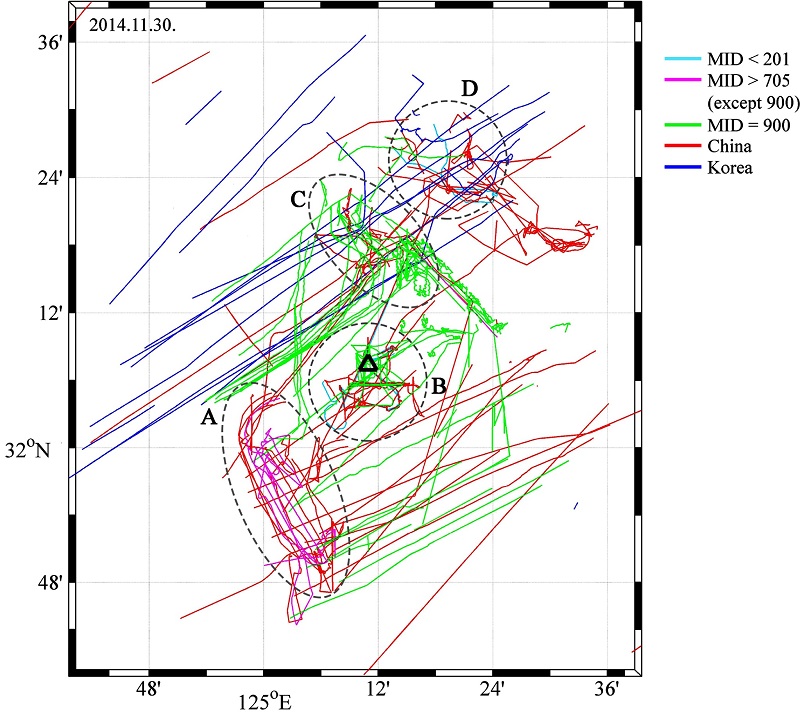
Classification of Passing Vessels Around the Ieodo Ocean Research Station Using Automatic Identification System (AIS): November 21-30, 2013
In this study, we installed the Automatic Identification System (AIS) receiver on the Ieodo Ocean Research Station (IORS) from November 21 to 30, 2013 in order to monitor marine traffic and fishery activity in the jurisdictional sea area. The collected AIS raw data consist of static data report (MMSI, IMO NO., Call Sign, Ship Name, etc.) and position information report (position, speed, course, etc.), and the developed program was applied to classify ships according to ship flag and type information. The nationalities are released from the first three-digit numbers (MID) of MMSI, but in general most of small ships do not send an exact ship flag through Class B type AIS, a simplified and low-power equipment. From AIS data with flag information, ships under the flag of China had the highest frequency and the second was Korean flag, while in ship type cargo and fishing vessels were dominant in sequence. As for the ships without flag information, we compared the tracks with others in order to estimate ship flags. It can be said that fleets of ships with Chinese frequently appear sail together for fisheries over the waters, because the unknown ships followed a similar moving pattern with Chinese fishing vessels.
초록
본 연구에서는 2013년 11월 21일부터 30일까지 9일간 이어도 종합해양과학기지에 선박자동식별장치(AIS)를 설치하여 관할해역과 한·중 잠정조치수역의 항행 선박 및 어업활동을 모니터링하기 위해 선박정보를 수집하였다. 수집된 AIS 원시자료는 자체적으로 개발된 프로그램을 이용해 선박의 고유정보(해상이동업무식별번호, IMO 번호, 호출 부호, 선명 등)와 위치정보(위치, 속력, 침로 등)를 추출하고, 국적과 선종 정보만을 이용해 선박을 분류하였다. 선박의 국적정보는 해상식별부호(MID)로 파악되는데, 소형선박에서 많이 탑재하고 있고 기능이 보다 간소화된 소출력의 Class B AIS는 국제해사기구(IMO)의 탑재 요건을 따르고 있지 않아 국적을 알 수 없는 선박이 다수 존재함을 확인하였다. 국적정보를 가지고 있는 선박 중에서는 중국선박과 한국선박이 많았으며, 선종정보를 가지고 있는 선박 중에서는 화물선, 어선 순으로 많았다. 또한 국적을 알 수 없는 선박의 특성을 파악하기 위해 이어도해양과학기지 주변의 항행빈도수가 높은 중국선박과 한국선박의 항적과 비교하였으며, 이를 통해 국적미상 선박이 중국선박의 항행경로와 높은 유사성을 보이는 것을 확인하였다. 따라서 이 해역에서 중국어선은 선단의 형태로 자주 출몰하는 것으로 판단된다.
Keywords:
AIS, Marine traffic environments, Ieodo ocean research station, 선박자동식별장치, 해상교통환경, 이어도 종합해양과학기지1. INTRODUCTION
According to Statistics Korea (KOSTAT), there were more than 600 marine accidents every year since 2009. More than 65% of the accident over the total accident is due to engine failure and collisions of fishing vessels. Also in the statistics of the year 2013, the number of accident occurrence in the territorial sea was significantly higher than the number in open port or channel entrance and especially in the Yellow Sea and the South Sea rather than in the East Sea of Korea. In addition to marine accident occurrence, we have to consider the decrease of fishery resources in the Korean waters due to competitions in fishery, and to conduct a surveillance of illegal operation of Chinese fishing boats, the necessity raised up for the navigation safety control system of vessels.
The International Maritime Organization’s (IMO) International Convention for the Safety of Life at Sea (SOLAS) requires Automatic Identification System (AIS) to be fitted aboard international voyaging ships with gross tonnage (GT) of 300 or more, and all passenger ships regardless of the size (1974 SOLAS, 2000 Amendments, Chapter V). In Korea, according to the Article 73 of enforcement regulation of Ship Safety Act, the following ships must install AIS in Korea; passenger ships with more than 2GT according to Marine Transport Act and excursion ships with more than 2GT according to Excursion Ships and Ferry Business Act. Also ships on international voyages with more than 300GT except passenger ships, ships on non-international voyages with more than 500GT except passenger ship. The tug boat, tanker or vessels transporting hazardous material sailing open ocean with more than 50 tones are also under obligation to install. In case of fishing boat, ships length over 45 m and with more than 5GT have to install according to Article 42-2 of the enforcement regulation of Fishing Vessels Act.
Vessels on international voyage have to install Class A and vessels on domestic voyage can either install Class A or B. AIS is a navigational equipment capable to detect object in area where even radar can’t since the shade of obstacles (Lee[2014]). It has advantage of providing information in update interval together with maritime mobile service identity (MMSI) number, dynamic information like as position, course, speed, veering status of the vessel and static information like as ship’s name, ship specification, ship type, destination (IMO[2010]).
Radar and satellite systems can also be used to monitor ship traffic. Yang[2008] developed some techniques of automatic ship detection from RADARSAT-1 SAR image. Yang and Ouchi[2008] applied the inter-look cross-correlation method for an enhancement of ship detectability using ENVISAT ASAR data. Chaturvedi et al.[2012] suggested the SAR and AIS integration procedure consisting of time matching, position matching, size matching, and speed matching. Hong et al.[2013] presented a target detection and tracking algorithm developed for FMCW radar image through the comparison with AIS information. These studies could be a part of the development of an integrated monitoring system using SAR, AIS, and Radar.
Previous studies have been conducted on SAR or radar applications for ship detection, but there is a lack of research on the validation of AIS data, considered as a reference data. It is said that fishing vessels do not send AIS signals correctly. The aim of this study is to investigate AIS data collected mainly for fishing boats and to contribute to a AIS-based monitoring system on the Ieodo Ocean Research Station (IORS). The collected data are classified by flags and types of ship, and the occupying flag and type of ship are calculated in each cell of 0.1° around the IORS.
The composition of this paper is as follows. In Section 2, the experiment on the IORS and processing of AIS decoding are described. The results are reviewed by the distribution maps and statistic graphs by the ship flags and types, and characteristics related with Class B AIS are given in Section 3, followed by conclusions in Section 4.
2. DATA AND METHODS
2.1 Ieodo Ocean Research Station
Ieodo situated 149km away from Marado, which is located in South of Jeju Island is an underwater reef where the depth is approximately 4.6 m (Fig. 1). Its surrounding sea area is an important area from a variety of views such as economy, ocean science and military. Ieodo Ocean Research Station mounted on the rock is a suitable place for maritime surveillance because it’s close to neighboring countries and so high traffic exist and lots of fishery activities are going on. AIS receiver was installed on the IORS to get the ship’s information from 21 November 2013 15:30 (LT) to 1 December 2013 11:54 (LT). In Fig. 1 (right, enlarged map), the solid circle indicates the maximum radius (100 km) of AIS data acquired on the IORS.
2.2 Extraction of Ship’s Information
When data are received from AIS, it is a raw data that is ASCII code so it needs to go through decoding process. After convert ASCII code to binary, we can classify with AIS message ID that has a value of 1 to 27 and we only used six of message. The message ID 1, 2 and 3 is for Class A and it includes position report of ship, with dynamic information like as speed, direction, and position. Message ID 5 is also for Class A but it includes static and voyage related data with static information like as name dimension, type, and destination. Message ID 18 is for Class B with dynamic information and message ID 19 is also for Class B with dynamic and static information. Binary data of each bit contains information and from AIS guidance (IMO [2010]), we can find what information of each bit contains. All available information are extracted on the basis of manual. The final output was collected by convert binary to decimal number. Accordingly, all obtainable information which includes Message ID and Maritime Mobile Service Identity (MMSI) are collected as decimal number and string.
MMSI is composed of 9 digit numbers, and used for specific equipments in maritime digital selective calling (DSC), AIS, radio station of a ship or a coast. According to the ITU-R Recommendation M585-6, MMSI format is M1I2D3X4X5X6X7X8X9, where first three digits indicate MID and X is any figure from 0 to 9. MID range is from 201 to 705, and denotes the administration (country) or geographical area (e.g. China uses 412 and 413, and Korea uses 440 and 441).
3. RESULTS AND DISCUSSION
3.1 Ship Flag and Type
In order to investigate the characteristics of most distributed vessels in the particular area, we produced a map with a grid spacing of 0.1°. The type of ships and flag data were accumulated in every each grids for one day and the most dominant ones in each grids were extracted. Fig. 2 and Fig. 4 show distribution of the most dominant ship flag and type in each grids respectively as indicated in bottom side color bar where each color represents the corresponding index. For example, in Fig. 2, blue color area indicates where most of ships without flag information. As I mentioned above, even though MID has a range from 201 to 705 basically, there are many AIS data having MID less than 201 or greater than 705. Almost flag information of ships equipped with Class B type AIS has strange MID since these ships does not have duty offering flag information. In Fig. 2, the number of ships without flag information or Chinese ships are dominant around the IORS. It also shows that there are many Korean vessels in North of the IORS from November 22 to 26.
To confirm the status of nationality around the IORS, we present through not only the distribution map as shown in Fig. 2 but also the graph of statistics in Fig. 3. In Fig. 3, the x-axis shows major nationality and y-axis shows the number of ship. Through this graph, we were able to find that there is the highest traffic in November 30, and ships without nationality information or Chinese ships are superiority.
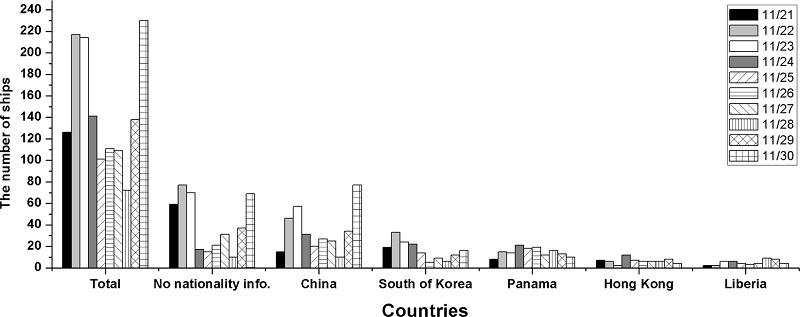
Classification chart according to flag of a ship, calculated from daily AIS data for the period November 21 to 30, 2013.
The results of regional distribution map considered with ship’s type are shown in Fig. 4. In Fig. 4, there are many ships without type information near the IORS and farther side of the IORS has high number of cargo ships. The item “No type information” means the AIS data from ships without ship’s type information. Statistic graph (Fig. 5) certainly shows that the ships without type information is the highest except the date, November 28. Similar to the results that was considered with flag, this results show that the superiority of ships that can not obtained the shipping information via AIS was confirmed.
3.2 Characteristics of Class B type AIS
AIS information is divided into two classes (Class A and B) depending on the AIS transponder and transmitting the AIS information. Class A type AIS is satisfied with AIS loading requisite of IMO while Class B type AIS is defined to provide only some functions, but not all. As I mentioned in section 2.2, Message ID provides the Class information of received AIS data. Therefore, we assumed that users using Class A type AIS must enter the ship’s information correctly. However, we are unsure that the ships equipped with Class B type AIS offer correct information since these ships are not mandated by IMO.
In this results, most of ships without flag and type information equipped with Class B type AIS. The percentage of the ships equipped with Class B type AIS in whole ships are shown in Fig. 6. The percentage is computed from the number of ships equipped with Class A or Class B types of AIS in each grid. In Fig. 6, data acquired from Class B type AIS is increased as ships comes closer to the IORS. It is because Class B AIS has week output unit of 1.5 kw and therefore it can only the station nearby can get AIS information (Jeong and An[2006]). We confirmed that the ships equipped with Class B type AIS was dominated nearby the IORS from that the percentage of Class B is almost 100%.
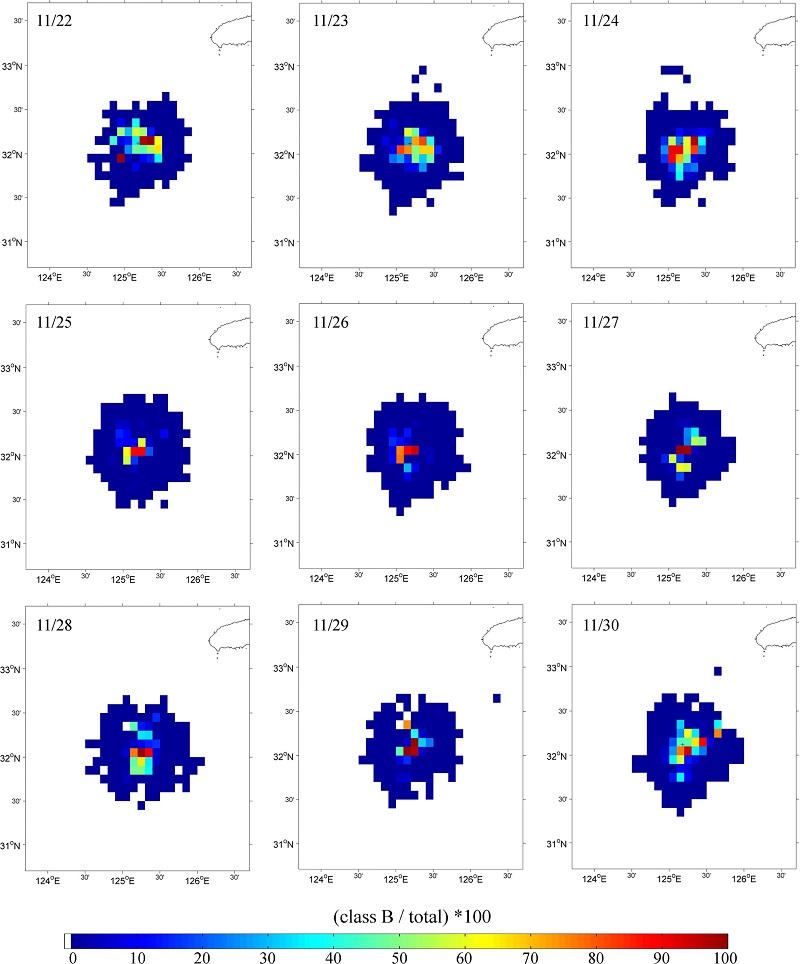
Percentage distribution of ships equipped with Class B AIS in each grid (grid size: 0.1°) from November 22 to 30.
Table 1 shows statistics according to information of ships. All of ships equipped with Class A type AIS have flag and 22.88% of ships did not provide type of ships information. However, in case of the ships equipped with Class B type AIS, 43.80% and 73.76% had unknown flag and unknown type information respectively. According to the received information from AIS, the ships of China equipped with Class B type AIS was 86.17%, whereas all of ships of Korea have Class A type AIS. In addition, the ships that have not provide the type information are 37.15% in Korea and 61.01% in China respectively. Even though all Korea ships have Class A type AIS, 20.17% of ships have no type information. The results of ships with unknown flag can be founded at the bottom in Table 1. As I mentioned above, flag information can be obtain using the MID ranging from 201 to 705. The MID that does not belong to the range was classified into two types as MID of 1) 900 and 2) less than 201 and more than 705 except 900. The ships with MID of 900 were separated since these took 63.72% of ships without flag and they always appeared around the IORS.
It was confirmed that many ships with unknown flag were sailing around the IORS. The navigational characteristics of the ships that have not nationality information was evaluated through trajectory comparison of ships as shown in Fig. 7. Fig. 7 shows one of the results of Class B, Chinese and Korean ships trajectory comparison on November 30 2013 and black triangle represents the position of the IORS. In this figure, cyan, magenta, green, red and blue color lines represent MID of less than 201, more than 705, 900, Chinese and Korean ships respectively. The area A shows ships with MID of more than 705 navigated together with Chinese ships, and the area B shows ship with MID of less than 201, ships with MID of 900 and Chinese ships existed around the IORS. Also in the area C, a lot of ships with MID of 900 moved with Chinese ships. In area D, ships with MID of 900 and less than 201 moved together with Chinese ships. Most of ships with unknown flag seem to be fishing boat since they move slow with a zigzag path nearby the IORS even in the Northwestern area of the IOSR. It was confirmed that the trajectory of ships with MID of greater than 705, especially 900 follows a similar movement with Chinese ships.
4. CONCLUSIONS
In this study, ships nationality and type near the IORS are confirmed using AIS data acquired from November 21 to 30 2013. The most dominant ship’s nationality and type are investigated regionally and statistically using the distribution map and graph of statistics. Among the ships that equipped AIS, Chinese ship is the most in the classification by nationality and cargo ship is the most common in the classification by ship’s type. It is confirmed that the ships of 44% did not provide the appropriate nationality information and the ships of 74% did not offer type information. In order to understand the characteristics of the ships have unknown flag, the trajectory was compared with Chinese and Korean ships. As a result, it is confirmed that the navigation trajectory of the Chinese ship and unidentified ships were very similar. We will determine the exact shipping status through a systematic monitoring system in the future.
Acknowledgments
This research is part of R&D Projects of MOF (Development of Safe Voyage Planning System for Vessels Operating in NSR, Construction of Ocean Research Stations & their Application Studies(M57972), KOOS(M58331)) and KIOST (E99185 and G48350). We thank Mr. Ji-Hun Back for AIS data acquisition on the Ieodo Ocean Research Station.
References
-
Chaturvedi, S.K., Yang, C.S., Ouchi, K., and Shanmugam, P., (2012), Ship recognition by integration of SAR and AIS, The Journal of Navigation, 65(2), p323-337.
[https://doi.org/10.1017/S0373463311000749]

-
Hong, D.B., and Yang, C.S., (2013), Algorithm implementation for detection and tracking of ships using FMCW radar, Journal of the Korean Society for Marine Environment and Energy, 16(1), p1-8.
[https://doi.org/10.7846/JKOSMEE.2013.16.1.1]

- IMO, (2010), Circular 289: Guidance On the Use of AIS Application-Specific Messages.
- Jeong, J.S., and An, K., (2005), A study on a domestic technical standard and effective introduction of Class B AIS for Non-SOLAS vessels, Proceeding of Korean Society of Marine Environment and Safety 2005, p53-58.
-
Lee, D.J., (2014), Integration of AIS and radar target information for offshore fishing vessels, Journal of Korea society of Fisheries Technology, 50(1), p21-29.
[https://doi.org/10.3796/KSFT.2014.50.1.021]

- Statics Korea, (2013), http://www.index.go.kr/potal/main/EachDtlPageDetail.do?idx_cd=1770.
- Yang, C.S., (2008), Automatic detection approach of ship using RADARSAT-1 synthetic aperture radar, Journal of the Korean Society of Marine Environment & Safety, 14(2), p163-168.
- Yang, C.S., and Ouchi, K., (2008), Study on ship detection using SAR dual-polarization data: ENVISAT ASAR AP Mode, Korean Journal of Remote Sensing, 24(5), p445-452.

